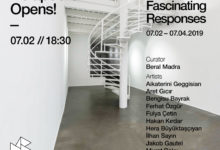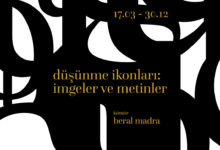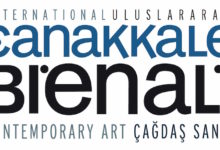THE CLANDESTINE LIFE OF OBJECTS
APRIL-JUNE 2019
Evliyagil Dolapdere Gallery Exhibition Concept
The exhibition in Evliyagil Dolapdere Gallery will focus on the uncanny or abject objects created since two decades. These works reflect the all-powerful presence of these investigative three dimensional works in the socio-cultural environment of Turkey as well as the artists strength of purpose to visually fabricate and present objects, which provoke the society of spectacle to face an uncanny effect.
The term uncanny appears at first Ernst Jentsch’s 1906 essay, On the Psychology of the Uncanny(1)and it was particularizedby Freud’s 1919 essay The Uncanny. Jentsch defined the uncanny as a product of intellectual uncertaintyand Freud rejected this uncertainity: There is no question, therefore, of any “intellectual un- certainty”; we know now that we are not supposed to be looking on at the products of a madman’s imagination be- hind which we, with the superiority of rational minds, are able to detect the sober truth; and yet this knowledge does not lessen the impression of uncanniness in the least degree. The theory of “intellectual uncertainty” is thus incapable of explaining that impression.(2) He associatedthe uncanny tothe realm of his aesthetic investigations, which later influenced Surrealism.
Heidegger describes in Being and Time (1927) (3) the feeling of not being at home with oneself or to be estranged about something as uncanny, which corresponds to Freud’s: The uncanny was not to be found in the exotic but in the everyday. In other words, one can have the same feeling of strangeness when one encounters objects which are not common or everyday objects. This feeling also includes any kind of alienation that is effective through the complex and insecure socio-political and cultural environmentssince the beginning of 20th century. Julia Kristeva, in her essay Abjection: Powers of Horrorrefers to Freud: Freud had strongly emphasized, at the outset of Totem and Taboo, “man’s deep aversion to his former incest wishes”. He had reminded us of the properties of the taboo: it is “sacred, consecrated; but on the other hand it means uncanny, dangerous, forbidden and unclean” (4). In her essay Abject is described as: It is something rejected from which one does not part, from which one does not protect oneself as from an object. Imaginary uncanniness and real threat, it beckons to us and ends up engulfing us. In the aesthetic realm of Post-modernism and Relational Aesthetics Abject and Uncanny became key terms for objects that have a function and perspective related to all these philosophy and psychoanalitic discourse.
The uncanny art works can thrust the viewer into a confrontation with the unusual, insecure and unfamiliar; all these conditions evoke the deep-rooted fear in front of the alienated, the obscure and the clandestine. However, paradox is that these artworks are mainly preoccupied with ordinary subject matter and about the everyday in all its familiarity; and precisely this aspect justifies Freud’s statement.. In other words he specifys that what used to be well-known, becames weird, that this peculiar transformation is frightening.
When viewing a work that deserves the term uncanny we can ask several questions: How can this work created with familiar forms and everyday articles be connected with the uncanny experience? What are the socio-cultural implications of these alien and dissimilar components that are combined to an entity? How is the imaginary preconception perceives the psychosomatic dimensions of this uncanny work? What is the spiritual effect of this familiarity versus rejection or oppression?
One can also argue that in the Freudian discourse the uncanny is emphasizing the social and political disposition of the unconscious. The work fluctuates between actuality and ingenuity, attraction and repulsion, familiarity and unfamiliarity. If the intention of the artist to create a representional strategy towards a crucial awareness, than this is not immediate and striking but has a paradoxical quality, which again is intentional. At first, the components of the work represent a familiarity and everyday reality, which predominantly represents the status quo or consumtion culture. At the second level, the combination of these images create the strangeness that confuses the desire of consumption and the reality of status quo.
The uncanny had many appearances throughout the centuries, from the Paleolithic and Neolithic up to Surrealism and today’s interdisciplinary and relations aesthetics. The Venuses of Europe’s tool-making Gravettian culture, created between 22,000 and 27,000 years ago; the Neolithic images on the walls of dwelllings in Aanatolia; the narration of Christianity on church walls or on icons have provoked an uncanny effect within the past and present viewer through the use of strange, weird, alien figures, animals, environments; they have always been distressing and repulsive as they were fascinating and alluring.
20th century avant-guards, consuming Freud’s analytical approach to the unconscious, created surrealistic images that expose all characteristics of the uncanny. Dreams, memory, recollections associations, horror, anxiety became the tool for representation of human condition of their time. The legendary film of Louis Bunuel and Salvador Dali Un Chien Andalou (1944)is the most effective example of this approach. As soon as the everyday objects was presented as an art object by Marcel Duchamp through his Pissoir – a most bizarre object to be displayed in a traditional art exhibition – the path to the uncanny art production was opened. Even if this phantasy of duality also opened the path of inquiry in the status of the art object, artists laboriously created the uncanny objects using new techniques and materials. Today, when we look to these works, we even think that in their appropriation of everday objects they are realistic but also surreal. The works of Hans Bellmer, Meret Oppenheim, Francis Bacon, Louise Bourgeoise, Mike Kelley, Robert Gober, Bruce Nauman, Edward Kienholz, Paul McCarthy, Sarah Lucas, Ron Mueck, Marc Quinn, Jake and Dinos Chapman, Patricia Piccini and many others are defined as animistic, magic, abject, uncanny and associated with sorcery, and categorised as uncanny and provoked a suppressed primordial fear, intellectual uncertainty. In the uncanny works one can even perceive an omnipotence of thought, an accidental reappearance, a paired and castrated image. In the Turkey’s Post-modern art production there is an early example of an uncanny object, namely IV Appearanceof Altan Gürman (1974),a simple 70 cm schematic figure made of paper and selulose which confronted all streotype convictions about the sculpture. Gülsün Karamustafa’s, Double Truth, 1987/2013 and Füsun Onur’s Untitled Füsun Onur(1993) chained chair are reflecting the feminist uncanny.
The exhibition presents several concepts and forms of creating uncanny objects.
Ekin Saçlıoğlu ‘s traditional domestic corner of cloth rack with pelts, horns and bone, Eda Aslan’s vegetative bookshelf, Memed Erdener ‘s wooden vacuum cleaner and Sena Başöz’s black cabinet filled with precious pieces of statuettes are strangely processed furnituresin sculptural terms. They approached the uncanny concept by considering the physical and tactile qualities of these common furnitures, but diverting their familar features into engrossing images. The other way of reflecting the Freudian uncanny is evidently gives the artist the possibility to enter into the mysteries of human body, sexuality and gender concerns. Yaşam Şaşmazer’s distorted heads with fungous, Erdal Duman’s gold femur, Sena’s feet that does not sink into the water, Mahmut Aydın’s mutilated body and Serkan Demir’s innocent looking emergency stretch captivates the gaze of the viewer towards an unfathomable interpretation and perception. Three works, the white wedding gown with images of Freudian dreams of Esin Turan, the white and sexy but skew shoes of Mehtap Baydu and meticulously slit Black Tie and Belt of Şakir Gökçebağ, intentionally placed next to each other in the exhibition, extend the Freudian uncanny to the source of today’s gender issues. Erim Bayrı with his scrapped metal structure reminiscent of traditional window cages and the gloomy iron potted flower, Devran Mursaloğlu with her handicraft black paper sheafs rythmically climbing to the wall and Özge Ezginöz with her mercilessly fossilized mushrooms borrowed from nature confronts the viewer with their material based works that are imparting dissident or speculative ideas visually perceptible and comprehensible. Argun Okumuşoğlu tests the humor of the viewer with a colossal divers bust, who possesses a yellow submarine in his googles. Viron Erol Vert submits into the arena of the uncanny three workers helmets, expected to protect them, however created with the most delicate material, porcellain.
In the age of Post-truth, late-Neocapitalism and socio-political turmoil the everyday life of the people is suffering under the symptom of continuous risk, which creates a culture of fear, so that sociologists define it as an age of anxiety. Artists who use the meaning and purpose of art for their socio-political opinions and concerns response to these circumstances with artworks that exploit the collective and individual anxiety through elusively combining the real and the surreal, the domestic and the jeopardy.
BERAL MADRA
1.On the Psychology of the Uncanny (1906)1 Ernst Jentsch, p.4,5,8,9,13
- https://web.mit.edu/allanmc/www/freud1.pdf,p.7
- https://blue-hermeneutics.org/2013/11/17/heidegger-on-the-uncanny-as-not-feeling-at-home/
- POWERS OF HORRORAn Essay on Abjection JULIA KRISTEVATranslated by LEON S. ROUDIEZCOLUMBIA UNIVERSITY PRESS New York 1982p.68 and p.13





